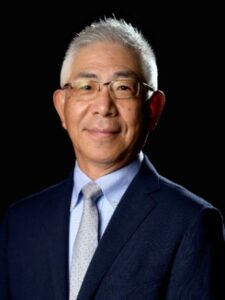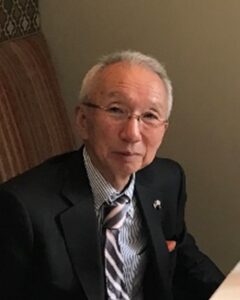69th MUMEI-JUKU(14/06/2024)
Theme: A research university that opens up the future – Tohoku University’s challenge
Guest Speaker: Dr. Hideo Ohno, Former President, Tohoku University , Special Advisor for Science and Technology, Ministry of Economy, Trade and Industry
[Brief Personal History]
Completed his doctorate at the Graduate School of Engineering, The University of Tokyo in 1982. 1982: Lecturer, Faculty of Engineering, Hokkaido University; 1983: Associate Professor, Faculty of Engineering, Hokkaido University; 1988-1990: Visiting Researcher, IBM T. J. Watson Research Center, USA; 1994: Professor, School of Engineering, Tohoku University; 1995: Professor, Research Institute of Electrical Communication, Tohoku University (2013-2018: Director, Research Institute of Electrical Communication, Tohoku University).During his tenure,2010:Director, Center for Spintronics Integrated Systems, Tohoku University; 2010: Chief Scientist, WPI Advanced Institute for Materials Research, Tohoku University; 2012: Professor, International Research and Development Center for Integrated Electronics, Tohoku University; 2016:Also Director of the Center for Spintronics Academic Cooperative Research and Education,Tohoku University. He was the 22nd President of Tohoku University from 2018 to March 2024. In March 2024, he became Special Advisor for Science and Technology, Ministry of Economy, Trade and Industry. Special Advisor to the President of Tohoku University in April of the same year.
From 2010 to 2014, he was a core researcher of “Research and Development of Energy-saving Spintronics Logic Integrated Circuits,” a cutting-edge research and development support program of the Cabinet Office, Government of Japan.
♦Opening Remarks by Dr. TAKEDA♦
Today, Dr. Ohno, who was President of Tohoku University until March of this year and is currently Special Advisor to the President, will speak on the topic of building the “future” of Japan. Dr. Ohno become Special Advisor for Science and Technology at the Ministry of Economy, Trade and Industry (METI) in April of this year, where he plays an important role in formulating strategies to pave the way for Japan’s future in education, advanced technology, semiconductors, AI, and other fields. He is also a leading researcher and educator of semiconductors in the world.
In addition to Dr. Ohno’s presentation material, I have prepared one additional document for reference, which shows Japanese government spending on education. In terms of GDP, the Japanese government spent about 5.5% of its GDP on education (public education) until around 1980, but since the collapse of the bubble economy, spending has declined sharply. Currently, it is at about 3.5%, the lowest level in the OECD. According to some intra-governmental discussions, if private education (the cost of kindergarten and/or university, which each family pays for) and public education are combined, spending on education is about 5-6%. However, it is known that the development of science and technology is not due to corporate R&D spending, but rather to the high level of R&D spending from the government, which increases the level of innovation in the country as a whole.
In fact, the U.S., which has been overtaken by China, has reaffirmed the importance of increasing R&D spending from the government again and has passed a series of bills such as the CHIPS & Science bill. I am not trying to apply this to education too quickly, but I do hope to see more research on the importance of “public education” in Japan in the future.
In any case, it is necessary for the government to provide large sums of money for future human resource development. In the U.S., it is said “no money, no mission,” and without a certain amount of money, the mission cannot be accomplished. Today, I would like to ask Dr. Ohno to talk about this mission.
♦Comments from Dr. TAKEDA♦
【Investing in Japan’s Nation Building】
While in Washington, D.C., I heard a story about the decreasing number of Japanese researchers in the U.S. In the U.S., the Think Tank has been very influencial, and in Asia,there are many researchers from China and South Korea, but few from Japan. As a result, there is less information and transmission from Japan. Chinese and Korean researchers are getting more and more information in their native languages and reflecting it in Think Tank reports, so that information from China and Korea can be disseminated. In the past few years, Korea and other countries have opened more than 50 endowed chairs at U.S. universities and secured professorships. Researchers and students gather under these professors.
Meanwhile, the number of professorships for studying Japan at U.S. universities is rapidly declining, and the number of researchers and students conducting research on Japan is also decreasing. The population is also aging. The number of Japanese endowed chairs in the U.S. is very small compared to Korea and other countries. This is a very big problem for Japan. Some may think that since there is no problem between Japan and the U.S., there is no need to do so, but this is not the case. In order for Japan and the U.S. to truly work together, there must always be one person after another who can see things from Japan’s perspective, China’s perspective from Japan’s perspective, and the U.S. perspective from Japan’s perspective, and so on. When I heard this talk in Washington, I really felt that we must once again start nation-building in Japan, especially in terms of education. The Japan we see from within Japan and the Japan we see from the outside are completely different. I am concerned that we are not investing in the next generation.
【The future of university cooperation between Japan and the U.S. and the future of Japan】
The 8th Japan-U.S. Digital Innovation and Advanced Technology Workshop, which has been of great interest to Dr. Ohno and the other presidents in attendance today, will be held at Ohio State University in September this year. Eight universities from Japan will participate in the workshop, and we hope that you will learn from the system of cooperation and collaboration. We believe that if we do not build on this approach, we will not be able to create a project originating from a Japanese university that will have a global impact.
The annual budget of Ohio State University (OSU) is well over 1 trillion yen. The University of Michigan, the University of Wisconsin, and other universities in the Midwest have annual budgets of more than that. I hope that you will learn from the Tohoku University case presented by Dr. Ohno today, and at the same time, talk directly with these university officials and others to learn how OSU is doing in the world, how the University of Michigan is doing, how Purdue University is doing, Johns Hopkins University is doing, and so on. Stanford and Harvard are not the only universities in the US. These universities in the Midwest are also thinking hard about the new era of universities.
The same is true for Japanese industry. I would like to see Japanese companies not only expand their presence in the U.S., but also consider ways to attract interest in Japan, such as by offering endowed courses at universities. Once again, we need to rethink our investment in Japan’s future.
【Changes in the U.S. and the Future of Japan】
As for the U.S., whether or not Trump becomes president again this November, I feel that the U.S. is about to abandon the international role it has played for nearly 80 years since the end of World War II. I believe that a great change in the world is coming. In this context, I think it is necessary for Japan to formulate a strategy for how to work together with the U.S. and how to live our next life.
【Discussion on Japan’s future】
In terms of education, I believe that private and national universities should cooperate with each other to discuss the big picture of how the nation should once again invest money in public education, rather than starting from small issues such as the correction of tuition fees between private and national institutions. How to deal with education in the midst of change and upheaval is a very important issue. In any case, as the first slide shown by Professor Ohno today indicates, the future is not a bleak one, and I believe that even more wonderful things await us beyond the bleak future. I urge all of you to continue to study with due diligence.


